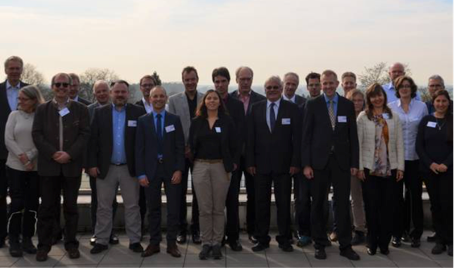Microparticles in the Aquatic Environment and in Food – Are Biodegradable Polymers a Feasible Solution for the “Microplastic Problem”? / MiPAq
Objectives
- Analysis of microplastic in sediment, water and food samples
- Comparison of biodegradable polymers with conventional polymers
- Automation of Raman Microspectroscopy
Methods of Approach
- SPLITT-Field-Flow-Fractionation using DoE tools
- Enzymatic digestion of samples
- Raman Microspectroscopy & Raman Imaging
- Automation with Labview and R
Description
Plastic is cheap, easy to manufacture and can be tailored to achieve desired properties, such as flexibility, durability, color and many more. This leads to a manifold of application fields from the simple plastic bag to high performance polymers. This versatility makes plastics essential to modern life, especially in the packaging industry. With growing plastic production, waste management becomes increasingly difficult. Although some polymers can be recycled, much of the plastic waste ends up in landfills. This is problematic as strategically important resources such as oil and energy are wasted if the plastic is not recycled. Furthermore, plastic waste contaminates the environment. Animals can mistakenly ingest plastic or become entangled in it. Plastic waste degrades into smaller fragments due to UV degradation of the incorporated plasticizers, which makes the plastic brittle and prone to mechanical decomposition, forming secondary microplastic (MP <5 mm). Within this process additives can be leached into the environment.
MP can also enter the environment as granulate from hygiene products or substrate for the production of plastic. This pristine MP is referred to as primary microplastic. MP of all origins can absorb and accumulate persistent organic pollutants as well as pathogens. These contaminates can be distributed over great distances for a long period of time, due to the durability of their plastic hosts.
This leads to the question if biodegradable plastics are a feasible solution to the “microplastic” problem. The replacement of conventional plastics could help reduce the residence time of plastic in the environments from centuries to weeks. Polymers are classified as biodegradable if they can be entirely decomposed to water and carbon dioxide by bacteria, fungi or algae. Biodegradable plastics can be made from fossil, as well as renewable resources. Thermoplastic starch (TPS) and poly lactide (PLA) currently dominate the market for bio based biodegradable polymers. Polyhydroxyalkanoates (PHA) are a recent addition to this segment.
Presently multiple procedures are available for the sampling, processing and analysis of MP samples. In this study a combination of enzymatic digestion, Field-Flow-Fractionation and Raman Microspectroscopy will be applied to MP in water, sediment and food samples.
As biopolymers are susceptible to degradation by peroxides, acids and bases, an enzymatic treatment will be used to remove organic contaminants from MP. This will help to reduce fluorescence overlap of the Raman fingerprint spectra. Processed samples will be analyzed at IWC-TUM by means of Raman Microspectroscopy.
SPLITT-Field-Flow-Fractionation will be tested for the separation of MP from sediment and other matrix materials, as it is a gentle preparation method. Herein a sample is divided into two fractions using a thin splitting cell. The particles are continuously added to the cell in a feed stream, which meets the carrier stream in the cell. Gravity acts as perpendicular force to the flow direction and leads to faster sedimentation of larger and denser particles than the targeted particles. The streams flow out of the cell via two different outlets, thus splitting the sample in two fractions (targeted/denser particles).
Raman Microspectroscopy is a powerful analytical tool for the chemical and optical analysis of particles, as it provides particle images and spectra. Through the images particles can be quantified (absolute number / MP number) and sizes can be determined. The spectra reveal the chemical identity of the particle and can indicate aging processes.
The automation of Raman Microspectroscopy will be achieved using Labview and should lead to a greater portion of the filter being analyzed. Currently only 3.6% can be covered with the semi-automated procedure. Furthermore, the automation will enable a higher sample throughput, which in turn will improve the timescale in which monitoring is possible.

Publications
E. von der Esch1, A. J. Kohles1, P. M. Anger, R. Hoppe, R. Niessner, M. Elsner & N. P. Ivleva, TUM-ParticleTyper: A Detection and Quantification Tool for Automated Analysis of (Microplastic) Particles and Fibers. PLOS ONE 2020 (1shared first authorship) doi.org/10.1371/journal.pone.02347
A. J. Kohles, E. von der Esch, P. M. Anger, R. Hoppe, R. Niessner, M. Elsner & N. P. Ivleva, TUM-ParticleTyper: Software and Documentation, mediaTUM, Mai 2020, doi:10.14459/2020mp1547636
E. von der Esch, M. Lanzinger, A. J. Kohles, C. Schwaferts, J. Weisser, T. Hofmann, K. Glas, M. Elsner & N. P. Ivleva, Simple Generation of Suspensible Secondary Microplastic Reference Particles via Ultrasound Treatment. Frontiers in Chemistry, section Analytical Chemistry 2020, doi:10.3389/fchem.2020.00169
P. M. Anger1, E. von der Esch1, T. Baumann, M. Elsner, R. Niessner & N. P. Ivleva, Raman Microspectroscopy as a Tool for Microplastic Particle Analysis. Trends in Analytical Chemistry 2018, 109 214-226 (invited, 1shared first authorship), doi.org/10.1016/j.trac.2018.10.010